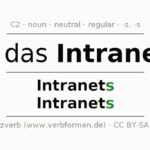Accessing an intranet is crucial for organizations to facilitate internal communication, collaboration, and information sharing. However, there are essential requirements that need to be met to ensure seamless and secure access. In this article, we will explore the key technical, authentication, access control, user experience, and collaboration tools requirements for accessing an intranet.
Key Takeaways
- Understanding the concept of intranets and their benefits
- Having a robust network infrastructure and security measures in place
- Implementing user authentication methods like Single Sign-On (SSO) and Two-Factor Authentication (2FA)
- Setting up user roles, permissions, and access levels for effective access control
- Ensuring an intuitive navigation, responsive design, and search functionality for a seamless user experience
Understanding Intranets

What is an Intranet?
An intranet is a private network that operates within an organization. It uses internet technologies but is accessible only to authorized users within a specific company, institution, or organization. It serves as a secure and private platform for employees to share information, collaborate on projects, and access internal resources and services.
Intranets are designed to facilitate communication and streamline workflows within an organization. They provide a centralized hub where employees can access important documents, company policies, and announcements. In addition, intranets often include features such as discussion forums, team calendars, and document management tools to enhance collaboration and productivity.
Implementing an intranet can greatly improve internal communication and information sharing, leading to increased efficiency and effectiveness in the workplace. By providing a secure and controlled environment, intranets ensure that sensitive company information remains confidential and accessible only to authorized personnel. Overall, an intranet is an essential tool for modern organizations to foster collaboration, streamline processes, and enhance productivity.
Benefits of Using an Intranet
An intranet provides numerous benefits to organizations. Here are some key advantages:
- Knowledge sharing: Companies can use the intranet to create knowledge repositories, where employees can access and contribute to essential resources, policies, and procedures.
- Document management: Storing and organizing electronic files, reducing paperwork, and ensuring easy access and version control within the company.
- Employee self-service: Offering HR modules through the intranet allows employees to manage their personal information, access pay slips, request leaves, and perform other HR-related activities.
- Extranet: Extranets are similar to intranets but extend access to external stakeholders, such as clients, partners, or suppliers, enabling collaboration beyond the organization’s boundaries.
Technical Requirements

Network Infrastructure
Network infrastructure is the foundation of any intranet system. It refers to the hardware and software components that enable the connectivity and communication between devices within the network. A robust network infrastructure is essential for ensuring smooth and secure data transmission. It includes routers, switches, firewalls, and servers, among other components. Reliability is a key factor in network infrastructure, as any downtime can disrupt the flow of information and hinder productivity. Organizations should invest in high-quality equipment and regularly update their infrastructure to keep up with technological advancements.
Security Measures
When it comes to accessing an intranet, security measures play a crucial role in protecting sensitive information and preventing unauthorized access. These measures are designed to ensure the confidentiality, integrity, and availability of data within the intranet system. Firewalls are commonly used to monitor and control incoming and outgoing network traffic, acting as a barrier between the internal network and external threats. Additionally, encryption techniques are employed to secure data transmission and storage, making it unreadable to unauthorized individuals. Regular security audits and penetration testing are conducted to identify vulnerabilities and strengthen the overall security posture of the intranet system.
Compatibility with Devices
Ensuring compatibility with devices is paramount for protecting sensitive business information while providing convenient access to employees. By leveraging the security features of Microsoft 365, organisations can ensure that their SharePoint Intranet is accessible on mobile devices without compromising data integrity or privacy. By optimising SharePoint Intranet for mobile access and user experience, organisations empower their workforce with the flexibility to collaborate, communicate, and access critical information from any location. This approach fosters a mobile-friendly digital workplace, enabling employees to stay productive and connected on the go.
User Authentication

Single Sign-On (SSO)
Single Sign-On (SSO) is a user authentication method that allows users to securely access multiple applications and systems with just one set of login credentials. With SSO, users only need to authenticate once, and then they can seamlessly navigate between different applications without having to enter their credentials again. This not only improves user experience by eliminating the need for multiple logins, but it also enhances security by reducing the risk of password-related vulnerabilities. SSO can be implemented using various protocols, such as SAML (Security Assertion Markup Language) or OAuth (Open Authorization). By implementing SSO, organizations can streamline access management and ensure a more efficient and secure user authentication process.
Two-Factor Authentication (2FA)
Two-Factor Authentication (2FA) is an additional layer of security that helps protect user accounts from unauthorized access. With 2FA, users are required to provide two different types of authentication factors to verify their identity. These factors typically include something the user knows (such as a password) and something the user has (such as a unique code generated by a mobile app). By requiring two factors, 2FA significantly reduces the risk of unauthorized access, even if one factor is compromised.
Access Control

User Roles and Permissions
User roles and permissions are essential components of an intranet system. They allow organizations to control access to sensitive information and ensure that employees only have access to the resources they need to perform their job duties. By defining user roles and assigning appropriate permissions, organizations can maintain data security and prevent unauthorized access.
To effectively manage user roles and permissions, organizations can implement a table that outlines the different roles and their corresponding access levels. This table can help administrators easily assign permissions and ensure that employees have the necessary access to perform their tasks.
In addition to user roles, organizations can also implement content restrictions to further control access to specific information. Content restrictions can be based on factors such as department, job role, and other permissions. This ensures that employees only see the information that is relevant to their job responsibilities.
To summarize, user roles and permissions are crucial for maintaining data security and controlling access to sensitive information within an intranet system. By implementing a structured approach to user roles and permissions, organizations can ensure that employees have the necessary access to perform their job duties while also protecting sensitive data.
Access Levels
Access levels in an intranet refer to the different levels of permissions and privileges that users have when accessing the system. These access levels are typically assigned based on the user’s role within the organization and determine what actions they can perform and what information they can access. It is important to carefully define and manage access levels to ensure the security and integrity of the intranet.
Implementing access levels can help organizations maintain control over sensitive information and prevent unauthorized access. By assigning different access levels to different user roles, organizations can ensure that only authorized individuals have access to confidential data and critical functions.
To effectively manage access levels, organizations can use a combination of user authentication methods, such as single sign-on (SSO) and two-factor authentication (2FA), to verify the identity of users before granting access. Additionally, access control policies and procedures should be established to govern the assignment and modification of access levels.
Organizations can also benefit from implementing a role-based access control (RBAC) system, which allows access levels to be assigned based on predefined roles and responsibilities. This simplifies the management of access levels and ensures that users have the appropriate level of access based on their job function.
Overall, access levels play a crucial role in ensuring the security and proper functioning of an intranet. By carefully defining and managing access levels, organizations can protect sensitive information, prevent unauthorized access, and promote a secure and efficient digital workplace.
Content Restrictions
Content restrictions play a crucial role in maintaining a secure and productive intranet environment. By implementing content restrictions, organizations can ensure that sensitive information is only accessible to authorized personnel. Confidential documents, financial data, and other proprietary information can be protected from unauthorized access.
To enforce content restrictions, organizations can use a combination of user roles and permissions. By assigning specific roles to users, organizations can control the level of access each user has to different types of content. For example, employees in the finance department may have access to financial reports, while employees in other departments may not.
In addition to user roles and permissions, organizations can also implement access levels. Access levels allow organizations to define different levels of access based on the sensitivity of the content. For example, highly sensitive documents may only be accessible to a select group of individuals, while less sensitive documents may be accessible to a wider audience.
To further enhance content restrictions, organizations can also implement content filtering. Content filtering allows organizations to restrict access to certain types of content, such as explicit or inappropriate material. By implementing content filtering, organizations can create a safe and productive intranet environment for all users.
In summary, content restrictions are essential for maintaining a secure and productive intranet environment. By implementing user roles and permissions, access levels, and content filtering, organizations can ensure that sensitive information is protected and only accessible to authorized personnel.
User Experience

Intuitive Navigation
Intuitive navigation is a crucial aspect of an intranet design. When employees are searching for content, they don’t immediately think about which department created that content. If the navigation shows a list of departments, employees may need to click through multiple department pages before finding what they are looking for. This can make it hard to find information efficiently. To address this, it is recommended to structure the intranet navigation by function, making it more user-centric and easier to understand.
Here are some best practices for user-centric navigation:
- Keep navigation labels simple and clear. Avoid using creative label names that may confuse employees.
- Renaming navigation labels with descriptive names, such as ‘Onboarding’ or ‘Benefits & Payroll’, can improve engagement and ease of use.
Implementing user-centric navigation can enhance the overall user experience and make it easier for employees to find the information they need.
Responsive Design
The responsive design of an intranet is crucial for ensuring a seamless user experience across various devices. It allows employees to access the intranet on-the-go, regardless of whether they are using a desktop computer, laptop, tablet, or smartphone. With a responsive layout, the intranet adapts and adjusts its design and functionality to fit the screen size and resolution of the device being used.
Implementing a responsive design not only improves accessibility but also enhances the overall usability of the intranet. Employees can easily navigate through the intranet, view and interact with content, and perform tasks without any limitations or difficulties caused by incompatible or non-responsive design.
To achieve a responsive design, intranet developers and designers need to ensure that the HTML, CSS, and JavaScript code are optimized for responsiveness. They should use media queries, flexible grids, and fluid images to create a flexible and adaptable layout that can accommodate different screen sizes and orientations.
In addition to responsiveness, it is also important to consider the performance and loading speed of the intranet on different devices. Optimizing images, minimizing HTTP requests, and using caching techniques can help improve the performance of the intranet on mobile devices with limited bandwidth and processing power.
Search Functionality
Searching and not finding is a pain. Why can’t searching on a modern intranet be as easy as Google? Three out of four employees search for forms, templates, and policies. So make those resources instantly visible before anything else. Keep them separate from all the other content on the intranet, and employees will find what they’re looking for in no time.
Make it easy to find colleagues with an employee directory. Employee directory is one of the top 3 resources employees use most frequently. It’s a must-have. It makes finding and connecting with colleagues effortless, fostering collaboration and knowledge sharing.
Implementing a search functionality that allows targeting news and events based on location, role, or security group can greatly enhance the user experience. By providing personalized search results, employees can quickly access relevant information that is tailored to their specific needs and interests.
To improve search efficiency, consider implementing features such as autocomplete suggestions, advanced filters, and search result sorting options. These features can help users narrow down their search and find the desired information more quickly and accurately.
Additionally, integrating the search functionality with other collaboration tools, such as document management systems and discussion forums, can further enhance the overall intranet experience. This integration allows users to not only search for documents and information but also engage in discussions and collaborate with colleagues in real-time.
Remember, the goal of search functionality is to make it easy for employees to find the information they need, when they need it. By implementing a user-friendly and personalized search experience, you can greatly improve productivity and efficiency within your organization.
Collaboration Tools

Document Management
Document management is a crucial feature of an intranet, allowing organizations to store and organize electronic files, reduce paperwork, and ensure easy access and version control within the company. By centralizing documents in a digital format, employees can quickly search for and retrieve the information they need, saving time and increasing workplace productivity.
To enhance document management capabilities, some intranets offer additional features such as:
- Collaborative Editing: Multiple users can work on a document simultaneously, making real-time updates and changes.
- Version History: A record of all changes made to a document, allowing users to revert to previous versions if needed.
- Metadata Tagging: Assigning tags or labels to documents to categorize and organize them based on specific criteria.
Implementing an effective document management system requires careful planning and consideration of the organization’s needs and workflows. It is essential to ensure compatibility with existing systems and to provide training and support to employees to maximize the benefits of document management on the intranet.
Team Calendars
Team calendars are an essential feature of an intranet, providing a centralized platform for tracking important events, milestones, and deadlines. With a company calendar, teams can stay in the loop and ensure everyone is on the same page. It allows for better coordination and planning, especially for distributed teams or remote work environments. The monthly calendar keeps everyone informed about planned absences, team meetings, and other significant dates. Additionally, team calendars can be integrated with task management systems, allowing team members to see what tasks each person is responsible for and the current status. This promotes transparency and collaboration within the team.
Discussion Forums
Discussion forums are a valuable tool for fostering collaboration and knowledge sharing within an intranet. They provide a platform for employees to ask questions, share ideas, and engage in discussions on various topics. By creating dedicated forums for different departments or projects, organizations can facilitate communication and encourage cross-team collaboration.
In addition to facilitating discussions, discussion forums can also serve as a repository of information. Employees can search for past discussions to find answers to common questions or to gain insights from previous conversations. This can help save time and prevent duplication of efforts.
To ensure the effectiveness of discussion forums, it is important to establish clear guidelines and encourage active participation. Moderators can play a crucial role in maintaining the quality of discussions and ensuring that the forums remain a respectful and inclusive space for all employees.
Overall, discussion forums are a powerful tool for promoting collaboration, knowledge sharing, and employee engagement within an intranet.
Conclusion
In conclusion, accessing an intranet is essential for maintaining data security and access control within an organization. SharePoint provides robust permission management features, allowing administrators to define access levels, roles, and responsibilities. Customization options for tailoring the intranet to specific needs are instrumental in creating a cohesive and engaging digital workplace. Mobile accessibility ensures that employees can access important information and collaborate on the go, fostering productivity and responsiveness. By optimizing SharePoint intranet for mobile access and user experience, organizations empower their workforce with the flexibility to collaborate, communicate, and access critical information from any location.
Frequently Asked Questions
What is an intranet?
An intranet is a private network accessible only to an organization’s employees, contractors, or authorized users. It is used for internal communication, collaboration, and sharing of information within the organization.
What are the benefits of using an intranet?
Using an intranet provides several benefits, including improved communication and collaboration among employees, centralized access to important information, increased productivity, and enhanced data security and access control.
What are the technical requirements for accessing an intranet?
The technical requirements for accessing an intranet include a stable network infrastructure, security measures such as firewalls and encryption, and compatibility with various devices and operating systems.
What is single sign-on (SSO)?
Single sign-on (SSO) is a user authentication process that allows users to access multiple applications or systems with just one set of login credentials. It eliminates the need for users to remember multiple usernames and passwords.
What is two-factor authentication (2FA)?
Two-factor authentication (2FA) is an extra layer of security that requires users to provide two different types of identification before accessing an intranet. This typically involves a combination of something the user knows (e.g., a password) and something the user has (e.g., a one-time verification code).
What is user authentication?
User authentication is the process of verifying the identity of a user who is trying to access an intranet. It ensures that only authorized users can access the intranet and helps prevent unauthorized access to sensitive information.




